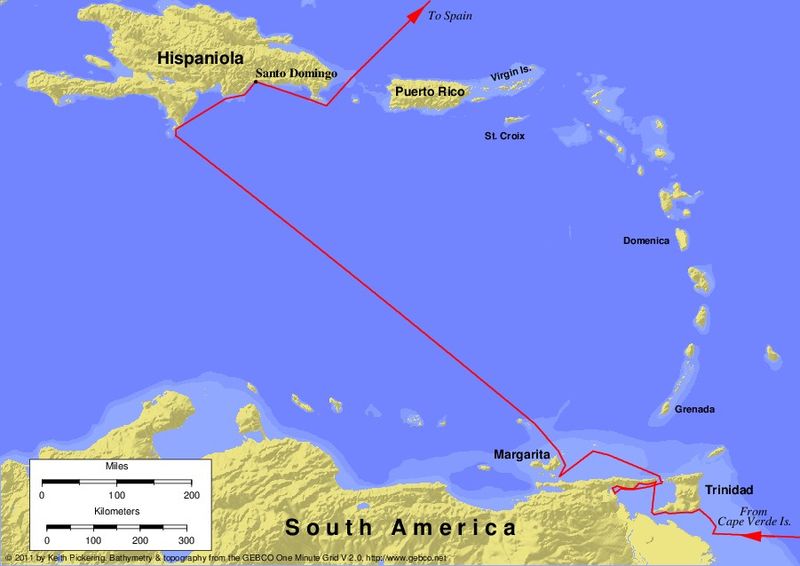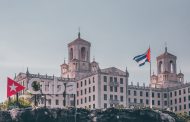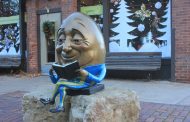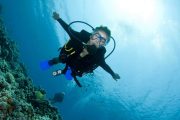How historical perspectives change: Different views of Christopher Columbus
History is not static. What is accepted as historical truth in one era is completely overturned in another? The reasons vary. It could be because new information has emerged to change how a famous person is viewed, or the accepted morality changes over time. For instance, at one stage slavery was widely practiced and regarded as acceptable by the people who bought and sold other human beings. It still exists today but is thoroughly detested and outlawed by most people and societies around the world because perspectives have changed.
A perfect example of how the way someone is seen can change is Christopher Columbus, once highly regarded as an intrepid explorer who opened up the New World of the Americas but now seen as a tyrant who treated people cruelly and enslaved and sold thousands of others. What is the truth of the matter? You be the judge.
You’ll read:
1. Who was Christopher Columbus?
2. Where was Christopher Columbus from?
3. Facts about Christopher Columbus
4. Four great Voyages
5. Christopher Columbus Legacy
Who Is Christopher Columbus?
Not much is known about Christopher Columbus’s early life. He is believed to have been born in Genoa to a Christian household, but it has been alleged that he was a convert from Judaism or that he was born in Spain or Portugal. Columbus became a famous Italian explorer, navigator, and colonist on behalf of the Spanish crown, who is accredited with “discovering” the “New World” of the Americas. He sailed across the Atlantic Ocean four times on behalf of King Ferdinand and Queen Isabella of Aragon, Castile, and Leon in Spain.
His voyages brought many hundreds of years of interaction and influence between the “Old World” of Europe and the Americas and the colonisation of the Americas by Europeans. He also led the initial expeditions from Europe to the Caribbean, Central America, and South America. Started out filled with hope and ambition, partially fulfilled by his title, which was “Admiral of the Ocean Sea” awarded to him in 1492, and by the grants given to him which were enrolled in the Book of Privileges (his titles and claims). However, by the time he died, he was a disappointed man.
Many books about Christopher Columbus, based on new scholarship, emerged in the 1990s, leading to a great deal of debate and argument.
This came about because of a change in interpretation when the old European understanding of historical events gave way to the understanding of people in the Americas themselves.
Instead of being regarded as a triumph, the European influence on the Americas, much of initiated by Columbus, was seen as a disaster for the indigenous peoples.
In the old scenario, Columbus was seen as the hero of four voyages, bringing profit to Spain and other countries in Europe, and opening up the Americas for colonisation.
But the new vision is of the destruction brought in terms of the slave trade and the deaths brought by new diseases on the population of the Caribbean and the Americas. The view of Columbus has changed to one in which he was seen as a hero to someone whose effects were disastrous and himself flawed. No one doubts his abilities as a sailor and navigator, but do not see him in a position of honor.
Where was Christopher Columbus from?
The name Christopher Columbus in Latin is actually Christophorus Columbus. His name in Ligurian, the native language of Genoa, where he was born, is Cristòffa Cómbo, in Italian, it is Cristoforo Colombo and in Spanish Cristóbal Colón. His father was Domenico Colombo, a wool merchant. His mother was Susanna Fontanarossa. Columbus’s brothers were named Bartolomeo, Giovanni Pellegrino, and Giacomo. He also had a sister named Bianchinetta.
Christopher Columbus is generally believed to have been born in about of before 1451. His life at sea started in what was effectively the merchant marine in Portugal in his teens. He was a sailor until 1470 when Pirates attacked his ship off Portugal. The ship floundered bu Columbus hung onto a piece of wood and made it back to land.
He went to Lisbon in Portugal where he studied many subjects including maths, astronomy, cartography (map-making and navigation. He eventually settled in Spain. He and his brother Bartholomew both worked as cartographers. In 1477 Columbus voyaged to Iceland and Ireland and in 1478 was in Madeira as an agent for the Centurioni company of Genoa.
Columbus based himself in Lisbon in Portugal from 1477 to 1485. He married Filipa Moniz Perestrelo, daughter of the governor of Porto Santo, the Portuguese aristocrat Bartolomeu Perestrello. His son Diego Columbus was born In 1479 or 1480. Filipa apparently died in 1485. Columbus had left Portugal for Castile in Spain in 1485, where, in 1487, he took Spaniard Beatriz Enríquez de Arana as his mistress with whom he also had a son, Fernando Columbus in July 1488.
Though mostly self-educated, Columbus was widely read in geography, astronomy, and history. He learned Latin, Portuguese and Castilian. He came up with an idea to look for a western sea passage to the East Indies. He hoped that by doing so he could profit from the lucrative spice trade. He is known to have traveled far and wide, as far north as the British Isles (and perhaps Iceland) and as far south as what is today Ghana in Africa.
Christopher Columbus facts
In the late 1400s, it was extremely difficult to travel from Europe to Asia by land. It was a long as well as a dangerous journey with hostile armies en route. Mariners from Portugal got around this by sailing there along the coast of West Africa and around the Cape of Good Hope.
But Christopher Columbus thought of a different plan, to sail west across the Atlantic and not go round Africa.
He believed, but this was not correct, that the earth was smaller than most people thought and that the voyage would not be very difficult.
He tried to interest officials in Portugal and England in his plan for years, without success. After long campaigning, Columbus managed in 1491 to persuade the Spanish monarchs to sponsor a voyage west.
He obtained their help after at least two rejections, mostly via Spain’s treasurer, Luis de Santángel, and of the Franciscan friars of La Rábida, where Columbus had stayed earlier that year.
Juan Pérez of La Rábida was one of the confessors of the queen and perhaps gained the critical audience for Columbus.
Spanish King Ferdinand of Aragon and his Queen Isabella of Castile, like Christopher Columbus, wanted to be rich and famous and the royal couple as well as Columbus, a devout Catholic, also wanted to export their religion to every part of the world. Columbus was promised that he could keep 10 percent of whatever wealth he could find. He would also get a royal title and become governor of any places he discovered on his travels.
Many people believe the popular idea Columbus had trouble getting finance for his voyages because people believed the earth was flat.
However, this is not correct. Nearly everybody who was educated at the time believed, as it had been believed since Aristotle’s time, that the Earth was round. It is also mentioned by Ptolemy, whose ideas were the basis of medieval astronomy.
Many Christian writers indicated that the Earth was round, include Saint Bede around AD 723. In Columbus’s time, celestial navigation, which uses the position of the sun and the stars with the knowledge that the Earth is round, was being used by astronomers and slowly by sailors. Even as far back in the 3rd century BC, Eratosthenes had worked out the circumference of the spherical Earth.
These measurements were known to scholars, but in Columbus’s time, there were miscalculations of the actual size of the Earth.
Christopher Columbus voyages
In the 1400s and 1500s, leaders of several European nations sponsored expeditions to foreign countries hoping they would find wealth and land. The Portuguese were the first in what later became known as the “Age of Discovery.” From about 1420, Portuguese ships called caravels moved off the African coast, carrying spices, gold, other goods and slaves from Asia and Africa to Europe. Other countries in Europe, especially Spain, were eager to share in the apparently massive wealth of the “Far East.” By the time the 15th century ended, Spain’s “Reconquista”– pushing Muslims and Jews out of the country after they had been at war for hundreds of years – was complete, and Spain went on to explore and conquer other parts of the planet.
In his letter at the beginning of the journal of his first voyage, Christopher Columbus describes what he hopes to achieve: Christian triumph and the westward route to the east.
His plan was to discover a route to the West to the rich land of China, to India, gold and spice islands of the east. Columbus wanted to rise to the ranks of the nobility and accumulate riches for himself and his family.
Between 1492 and 1503, Columbus sailed four voyages between Spain and the Americas, each sponsored by the Crown of Castile (Ferdinand and Isabella). These voyages launched European exploration and colonisation of the Americas and are very important in Western history.
Columbus was adamant, even though there was growing evidence that he was wrong, that the places he reached on these voyages were part of Asia as described by among others, Marco Polo.
This might explain why America is named after fellow Italian explorer Amerigo Vespucci and not after Columbus.

Christopher Columbus’s fleet leaving from Spain in 1492.
Kean Collection/ Hulton Archive/ Getty Images
First voyage of Christopher Columbus
The Nina, Pinta and Santa Maria
Three ships, the Nina, Pinta and Santa María were prepared at Palos in Spain. A royal treasury official put together a group of mostly Genoese and Florentine bankers in Seville to finance the voyage. Christopher Columbus provided over a third of the sum the king and queen contributed. Queen Isabella did not have to pawn her jewels (a myth Bartolomé de Las Casas made popular in the 16th century).
Columbus and his crew sailed on August 3, 1492. Columbus captained the Santa María, the Nina was commanded by Vicente Yanez Pinzon and the Pinta by Martin Pinzon. On October 12, the ships found land – not in Asia, as Columbus thought, but on one of the islands in the Bahamas.
He named the first island he found in San Salvador. The local people called it Guanahani. Columbus believed he was in Asia. He called the native people “Indians”. In letters he wrote to Spain, he described what the islands looked like and told of his encounters with the local people. He sailed all over the Caribbean and named many islands after his ship, king and queen: La Isla de Santa María de Concepción, Fernandina, and Isabella. He thought the island of Cuba was a part of China.
Columbus spent months sailing from island to island in the Caribbean, looking for treasure that he had promised the Spanish king and queen, but he found very little. It is difficult to determine exactly which islands he visited. One known place he stopped was in present-day Haiti. He named the island Hispaniola, which today includes the Dominican Republic as well.
In January 1493, Columbus went back to Europe. Rough seas forced him to land in Portugal. But Spain and Portugal were not on good terms the Spanish royals thought he might be taking information and/or goods to Portugal, where he had lived for some time. Columbus’s enemies would later use this against him.
Eventually, Columbus was allowed to go back to Spain to where he took tobacco, turkeys and new spices. He also brought some island natives whom Queen Isabella became very fond of. He left 40 men behind on Hispaniola in a settlement he called La Navidad. He thought that Hispaniola might be one of the wealthy islands from which King Solomon took gold, gems, and spices to Jerusalem. Or he thought it could be the legendary kingdom of Sheba. There Columbus found enough gold and prosperity to save him from ridicule on his return to Spain. The running aground of the Santa María on December 25, 1492, provided wood and food for the people left there.
Second voyage of Christopher Columbus
In the same year in which he got back to Spain, 1493, Christopher Columbus set sail again on his second expedition with a large fleet intending to conquer the local people and set up colonies.
The parrots, spices, gold, and slaves Columbus took to his sovereigns after the first voyage had persuaded everybody that another voyage should be arranged swiftly. Columbus was very popular and he led about 17 ships from Cádiz on September 25, 1493. Colonisation and spreading the Christian religion were part of the plans, and friars sailed with him.
More than 1000 paid men and about 200 investors and a cavalry troop accompanied him.
He explored many more Caribbean islands. When Columbus got back to Hispaniola, he found that the 40 sailors he had left at Fort Navidad had all been killed. He forced the local population to rebuild the settlement and look for gold. They found small amounts of gold but the local population hated them. More places were rapidly built, including a city named La Isabella after the queen. On 2nd February, Antonio de Torres left La Isabella with 12 ships, gold, spices, parrots and slaves (most of whom died), as well as the bad news about Navidad and complaints about Columbus’s harsh government.
Columbus’s brothers Bartholomew and Diego were left behind to govern the Hispaniola settlement. Columbus sailed around the Caribbean convinced he had found part of China. Instead of the riches he had promised the Spanish monarchs, he sent about 500 slaves to Queen Isabella. The queen was appalled as she believed people Columbus “discovered” were Spanish subjects who could not be enslaved and returned his gift.
As time passed, many natives were enslaved by the colonists. They sent a few to Europe and used many others for gold mining for the Spanish settlers in the Caribbean.
Third voyage of Christopher Columbus
On 30 May 1498, Christopher Columbus sailed with six ships from Sanlúcar, Spain, for his third trip to the New World, cautiously sponsored again by Ferdinand and Isabella. Three of the ships went to Hispaniola with supplies while Columbus took the other three south of the Caribbean islands he had visited, hoping to find a passage to Asia. Columbus was expected to find prizes and plant the Spanish flag in the East.
He did find prizes, but not the kind his royal sponsors wanted. He wanted to find a route from Cuba (his “Cathay”) to India. Columbus began the Atlantic crossing on 4th July from São Tiago (Santiago) in Cape Verde. He only reached the mainland of South America on this third voyage at the Orinoco River in what is now Venezuela. Columbus correctly interpreted the huge amount of water the Orinoco spewed into the Atlantic Ocean as evidence of a large landmass and not an island. He speculated that he might have found the Garden of Eden.
He didn’t find the strait to India, nor did he find King Solomon’s Mines, which he and his sovereigns had expected.
He also went to Trinidad and the South American mainland. But conditions at the Hispaniola settlement had worsened with settlers revolting against Columbus and his brothers, saying Columbus had misled them about the wealth they would find and reporting his brothers for bad management and brutality.
The Spanish king and queen sent a new governor to take over who, on behalf of the crown, arrested Columbus He went back to Spain in chains to appear before a royal court. On his journey home Columbus wrote a long letter to Ferdinand and Isabella showing complete faith in his navigation, claiming he had reached the Earthly Paradise. This convinced Ferdinand and Isabella to give Columbus another voyage as he was close to the prize. They ordered his release.
Columbus was suffering severely from insomnia, eye strain, and arthritis. He was now suffering from sleeplessness, eyestrain, and a form of rheumatoid arthritis. The charges were dropped but Columbus was stripped of his title of governor of the Indies and a lot of the wealth he had gathered on his trips. In October 1501 Columbus went to Seville to prepare his fourth and final voyage.
Fourth voyage of Christopher Columbus
The aging Christopher Columbus set sail on his last voyage in 1502, searching in vain for a route to the Indian Ocean. He wrote about 20 letters, some refuting the charges against him, others saying how close he was to the Earthly Paradise and the need to recapture Jerusalem. He began his Book of Privileges, which defends the Columbus family’s titles and financial claims. He also started the Book of Prophecies, which includes biblical passages.
In December 1502, Columbus and his crew found themselves in a very violent storm.
He got all the way to Panama where he had to abandon two of his four ships after an attack by hostile natives. His ships were damaged even more off the coast of Cuba. On June 25, 1503, they were beached in St Ann’s Bay, Jamaica. Columbus and his men remained stranded on Jamaica for one year.
A rescue party finally arrived, sent by the royal governor of Hispaniola in July, and in November of 1504 Columbus and his men were taken back to Spain with nothing to show for the trip. In his last two years, Columbus battled to recover his titles. He did get back some of his wealth in May 1505, but he never got his titles back. He died at Valladolid on May 20, 1506, due to illness and old age. He still believed, completely mistakenly, that he had found a short route to Asia.
The confusing legacy of Christopher Columbus
Today, Christopher Columbus’s legacy is mired in controversy. He is remembered as a brave explorer but he also set changes in motion that would decimate native peoples.
So great was his influence that the period before his arrival in the Americas is known as the Pre-Columbian era. His legacy is debated today. He was venerated for hundreds of years after his death but perceptions have altered over the years as historians have investigated darker aspects of his life, like his role in the extinction of native peoples and harsh treatment of Spanish colonists in territories he and his brothers ruled. Many places, including the country of Colombia, bear his name.
Columbus has been credited with “discovering” the Americas, and for being the first European to get to the “New World”.
This is incorrect as the Vikings got there in the 11th century, traveling to Greenland and Newfoundland.
Columbus is also credited with opening up the Americas to European influence and colonisation and his voyages did lead to centuries of exploration – but also exploitation – of the continents of North and South America. He is blamed for the destruction of the native people of the continents.
The consequences of Columbus’s explorations were severe for those the Spanish conquistadors conquered.
Illnesses for which they had no resistance, like smallpox and changes to the environment destroyed millions of people, most of the native populations in many areas, over time.
This allowed the European takeover of the Americas, while Europeans extracted resources, including gold, from these areas.
The Americas were changed forever and the rich cultures of the Native American civilizations were lost, denying the world a true understanding of them.
During what became known as the Colombian Exchange, Columbus’s expeditions started a massive transfer of people, plants, animals, diseases, and cultures that had an effect on nearly everyone on the planet. The horse, which was brought to the Americas from Europe, allowed Native American tribes to range far and wide hunting. Wheat from Europe became one of the major food sources in the Americas. Coffee from Africa and sugar cane from Asia went to Latin America and became export crops. Foods from the Americas, like potatoes, tomatoes, and corn, became staples for Europeans.
And he failed in his main goal and the purpose of all his voyages, to find the short route to Asia he had been looking for and the wealth it promised.
But the poor opinion of him may be partly unfair. Some things he has been blamed for may have been beyond his control and may have been due to the historical time to which he belonged. His religious beliefs, his enslaving of people and his execution of subjects come from a world remote from our democratic ideals, but it was the world he was born into and that was beyond his control.
Christopher Columbus’s influence remains in our modern world. Many places have been named after him and carry his name to this day:
Countries
Colombia
Jurisdictions
Colón Province, province of Panama; British Columbia, province of Canada; District of Columbia, the federal district of the United States, Columbia District (historical), disputed between the United States and the United Kingdom.
Major Cities
Columbia, Sou; Colón, Panama, second-largest city in Panama.
Towns named Colombia
Bolivia, Santa Cruz prov; Tolima prov, Huila prov, Atlantico prov, Cordoba prov, Cundinamarca prov, Casanare prov. Cuba, Las Tunas prov; Honduras, Atlantida prov, Peru, Madre de Dios prov; Venezuela, Apure prov, Monagas prov; Ecuador, Guayas prov.; Brazil, São Paulo prov., Bahia prov., Parana prov., Rio Grande do Sul prov; Sri Lanka.
Towns named Colon
Argentina, Bolivia, Colombia, Costa Rica, Cuba, Dominican Republic, Ecuador, El Salvador, Guatemala, Honduras, Nicaragua, Panama, Paraguy, Peru, Uruguay, Venezuela, Jamaica, USA, Netherlands Antilles
Settlements
Colombo, Brazil, municipality of the state of Parana; Columbia, Maryland, census-designated place; Columbia, California, city;
Columbus, Georgia, city; Columbia, Columbus, Mississippi, city; Missouri, city; Columbus, Indiana, city; Columbus, Montana, town;
Columbus, Nebraska, city; Columbus, Wisconsin, city; Columbus, Texas, city; Columbiana, Ohio.
US Countries
Columbia County, Georgia; Columbia County, Pennsylvania; Columbia County, New York; Columbia County, Wisconsin;
Columbiana County, Ohio.
Streets
Colon Street, Cebu, Philippines; Avenue Christophe-Colomb, Montréal, Québec, Canada; Columbus Circle, New York City.
Read another story from us: Know more about Li Ching-Yuen- 256 years oldest man on Earth
There are also buildings, ships, rivers and mountains named after Christopher Columbus in many parts of the world. So even though his legacy is controversial, these names are likely to remain for centuries to come.






















